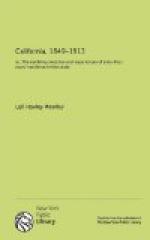Going north on Powell street, at No. 812, Mr. Chilion Beach, the bookseller, lived, while next door, No. 814, Mr. D. D. Shattuck resided. This building was erected in 1854 — Mr. Shattuck came to California via the Isthmus and resided here 47 years. On the next block (same side) stood a little one-story house with a high basement in which J. D. Spencer, a brother of Spencer the sociologist, lived for many years. Just beyond stood the old High School building. On the next block, at No. 1010, resided for many years another of the old booksellers, Mr. George B. Hitchcock, proprietor of the “Pioneer Book Store,” opposite the “Plaza.”
At the northwest corner of Washington stood the first brick building built in San Francisco. It was built in 1851 by John Truebody, the brick being brought from New York. It was originally two stories high but upon the grading of the streets it was built another story downward to the new grade. He later added another story, the fourth, on top. Even to the time of the fire (1906) you could see the various stairway landings on the Washington street frontage. Mr. Truebody originally owned this entire block.
The first church building in Yerba Buena (as San Francisco was formerly called) was the First Presbyterian Church on the west side of Powell near Washington. It was built in 1849 of hand-hewn timbers from Oregon. Upon the erection of the First Methodist Church it was moved to the rear and used as a Sunday school. John Truebody constructed it.
In this immediate neighborhood were many a frame building that had been brought around the Horn “in the knocked down state.”
Powell street, from Clay to North Beach, was graded in 1854. It and Stockton street to the east, from Sacramento street north to Green street, were lined with neat homes and was then considered the fashionable residence section of the city, while on Powell street were three churches.
The streets in those days were all planked. Beyond Mason streets ran the trail westward to the Presidio, past scattered cottages, sheds, dairies and vegetable gardens.
On the east side of Stockton street, between Sacramento and Clay streets, stood the old Pioche residence, wherein were given many lavish entertainments, for its owner was an epicure and hospitable to a degree. He was a heavy speculator and at one time possessed of much property. His death was a mystery and has never been solved. During the ’90’s his home was used as the Chinese consulate.
On the west side of Taylor street at the corner of Sacramento street stood the home of Capt. J. B. Thomas, after occupied by Addison E. Head, while on the corner of Clay I had my grocery business, living on the next block, between Clay and Washington, No. 1211. Win. T. Coleman, the leader of the Vigilance Committee, lived on the corner of Washington street; this house was built by W. F. Walton, and occupied in turn by S. C. Hastings, Wm. T. Coleman and D. M. Delmas, all men of prominence, while on the next corner stood the home of my old friend, Gross, who came across the plains with me in 1849. In later days, Mr. Chilion Beach resided there.




